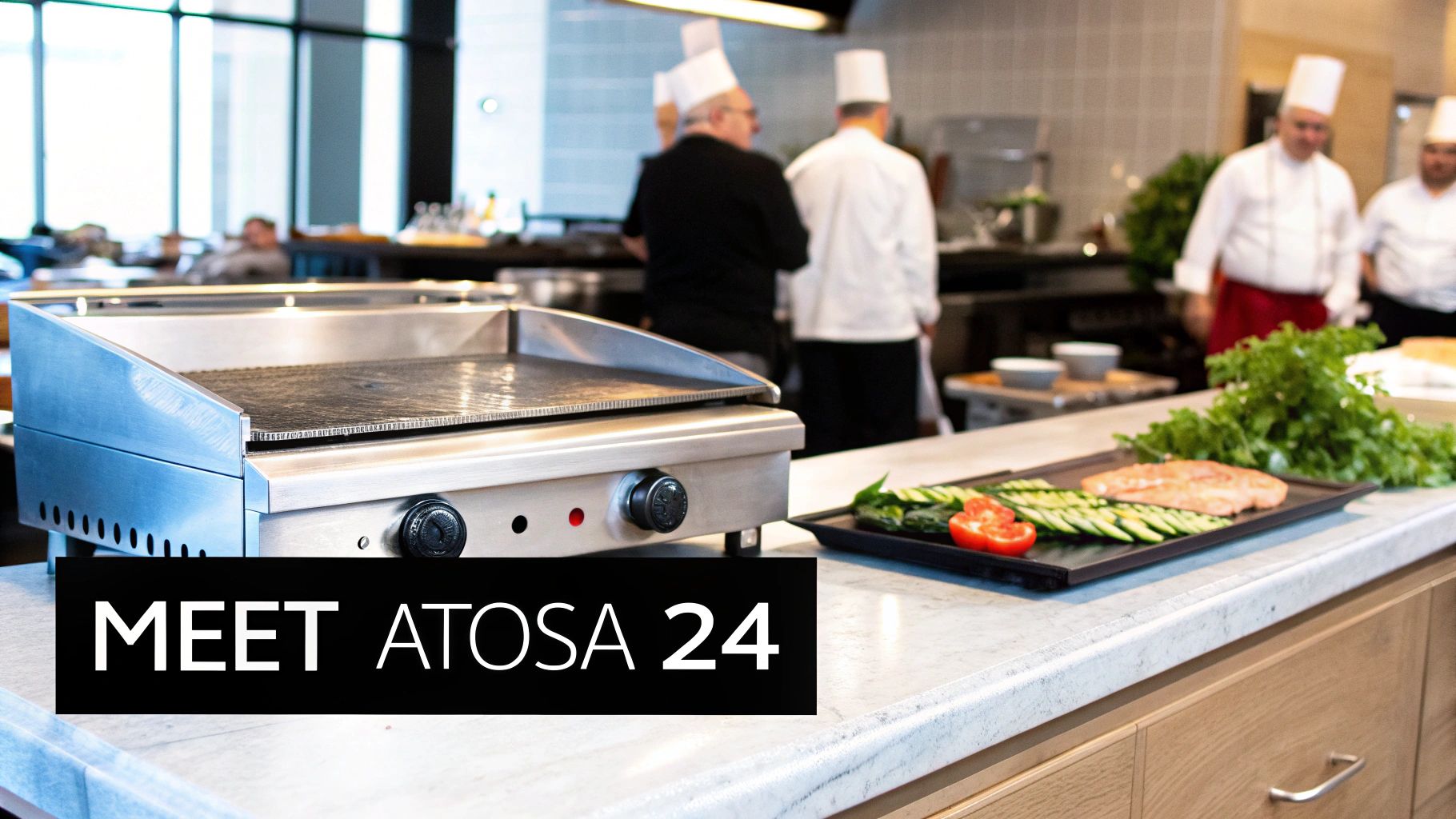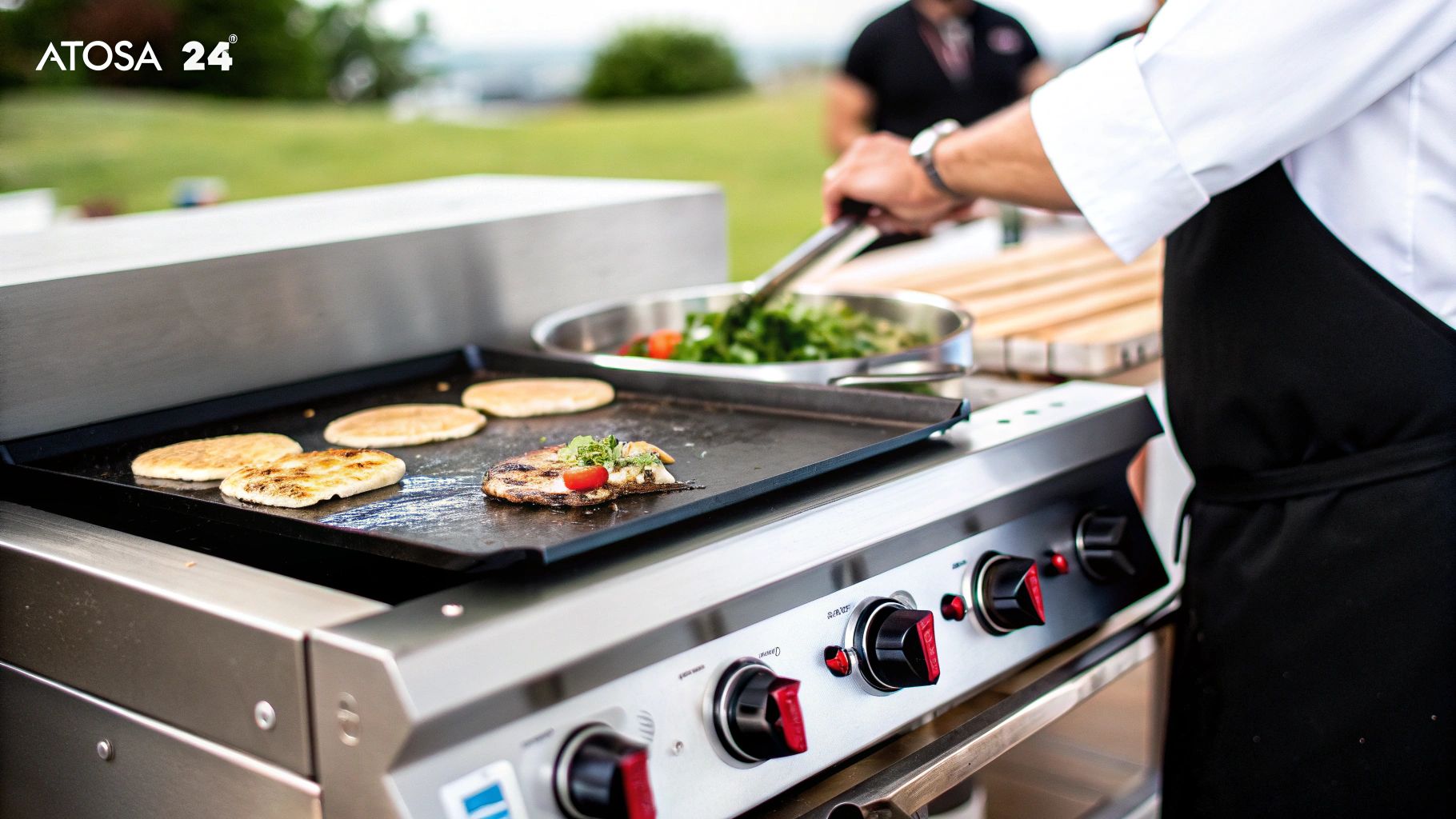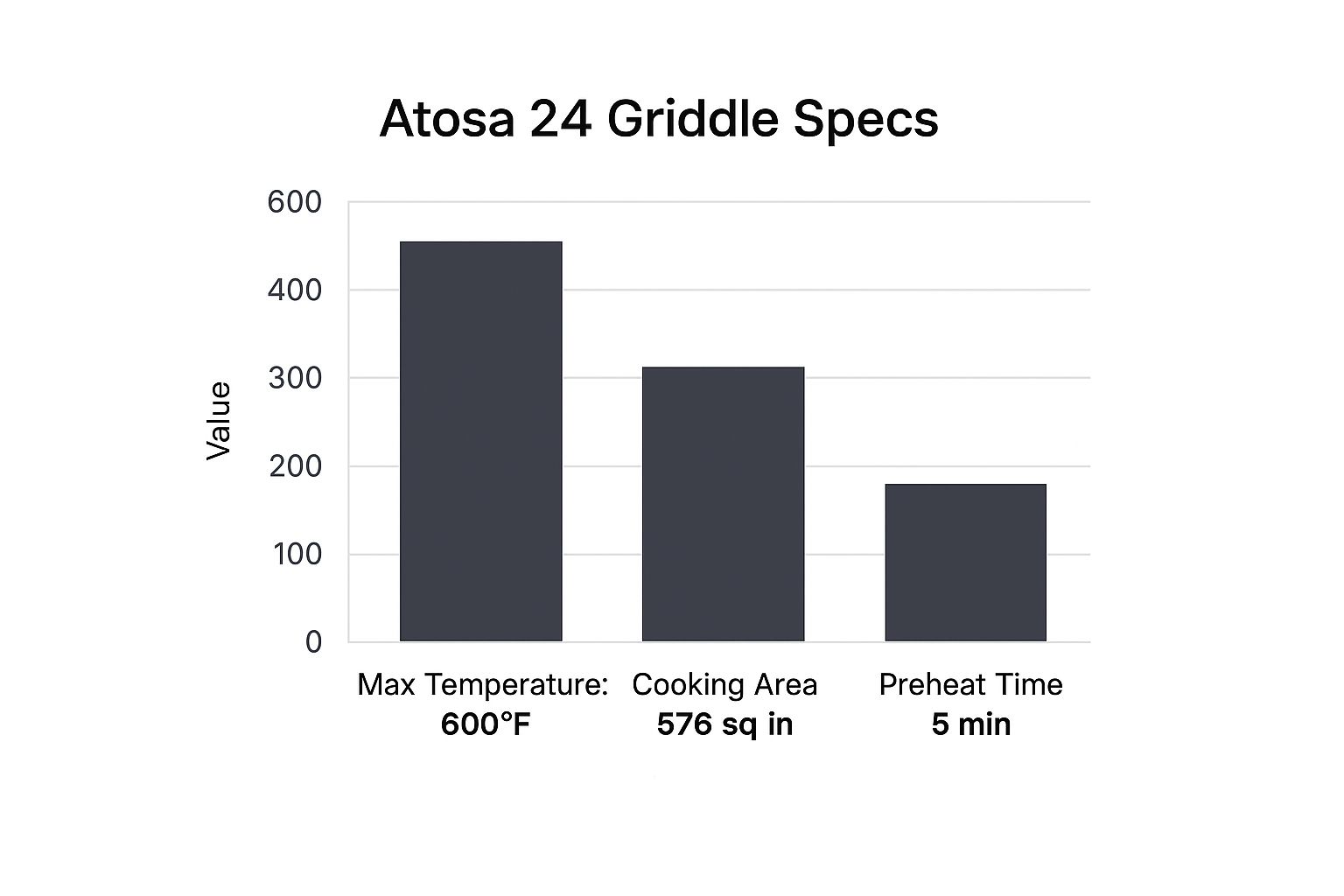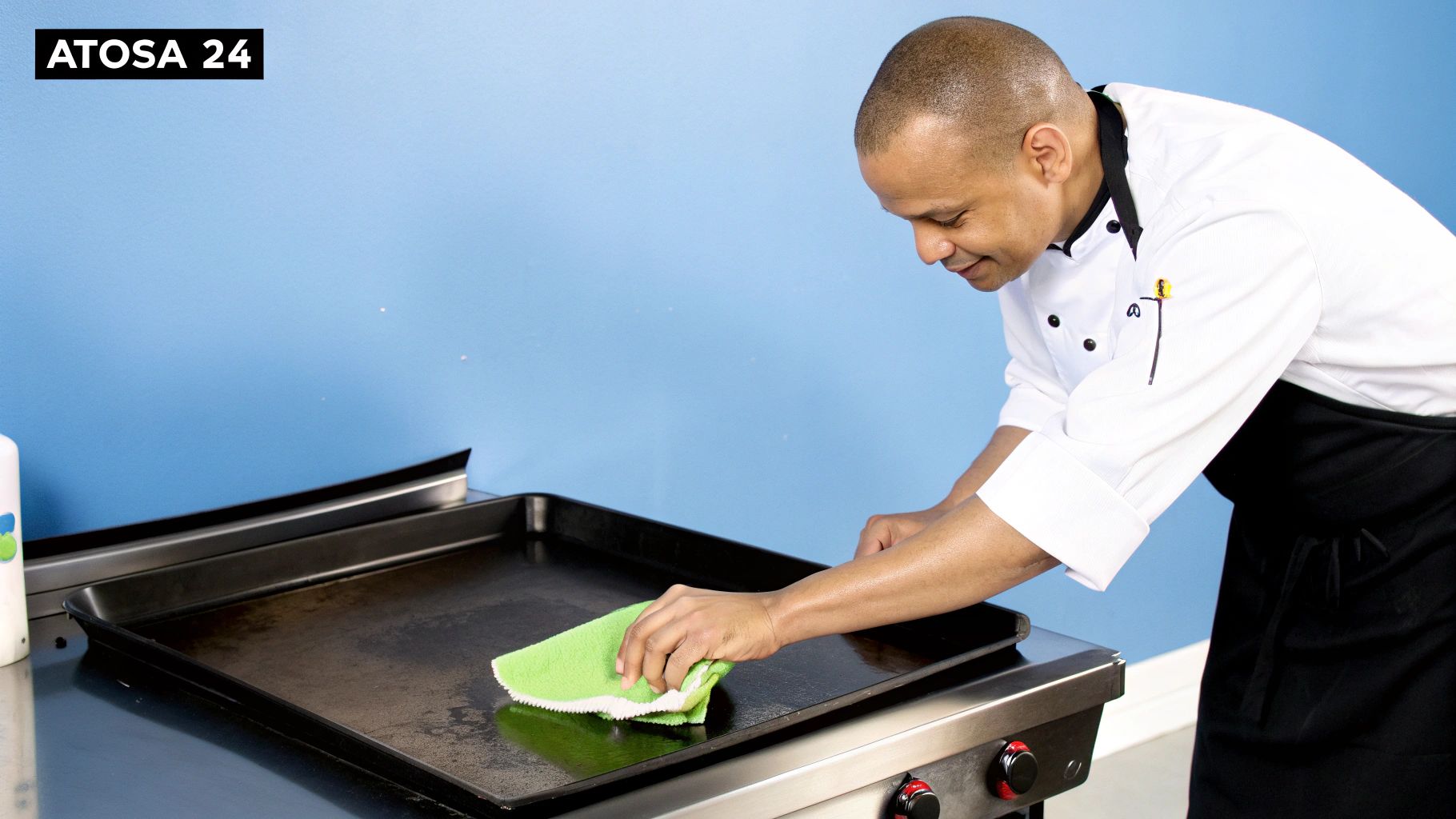
Atosa 24 Griddle An Expert Commercial Kitchen Guide
If you're looking for a commercial cooking unit that punches well above its weight class, the Atosa 24 griddle is one you need to know about. This isn't just another piece of equipment; it's a true workhorse built for professional kitchens that need consistent results without blowing the budget. It perfectly blends tough-as-nails construction with reliable power, making it a seriously smart investment for any high-volume spot.
Why a Commercial Griddle Is Your Kitchens Workhorse

In any professional kitchen, some gear is nice to have, and some is absolutely non-negotiable. A commercial griddle is firmly in that second camp. A commercial unit is engineered from the ground up to handle the relentless grind of a busy service, cranking out consistent, high-volume food hour after hour.
This is exactly where the Atosa 24 griddle shines. Atosa has carved out a solid reputation for building equipment that just works, day in and day out. They deliver the kind of durability and power chefs demand, but without the eye-watering price tag of some of the bigger brand names. What you get is a fantastic return on your investment.
Who Needs an Atosa 24 Griddle
The 24-inch size hits a real sweet spot for a ton of different kitchens. It gives you plenty of cooking real estate without completely taking over your cook line. It’s a perfect fit for:
- Bustling breakfast joints that need to flip endless stacks of pancakes, bacon, and eggs.
- Classic diners and cafes where the flat-top is king for burgers, cheesesteaks, and grilled sandwiches.
- Steakhouses that need a dedicated station to put that perfect, delicious sear on their cuts of meat.
- Food trucks and concession stands where every inch of space counts, but the menu has to be versatile.
This griddle is part of a huge and growing industry. The commercial cooking equipment sector was valued at a massive USD 13.8 billion in 2024 and is expected to climb to USD 22.4 billion by 2033. That growth is all about the global demand for dependable tools that can keep up with the pace.
Choosing the right equipment is all about matching the tool to the job. The Atosa 24 griddle is for the chef who needs efficiency, rock-solid performance, and long-term durability packed into one powerful unit.
At the end of the day, buying a unit like this is a strategic move for any kitchen that cares about quality and speed. If you're weighing your fuel options, be sure to check out our guide on the differences between natural gas vs propane griddles.
Breaking Down the Atosa 24 Griddle's Design
To really get what makes the Atosa 24 griddle a workhorse in a pro kitchen, you have to look under the hood. It’s built with specific materials and parts that directly lead to better cooking when things get crazy during service. This isn't just a random pile of steel; every piece has a job to do.
The backbone of the whole unit is its heavy-duty stainless steel construction. There's a reason this is the go-to material for commercial kitchens—it can take a beating, laughs at rust and corrosion, and is surprisingly easy to wipe down after a grueling shift. The welded seams and smooth finish mean fewer nooks and crannies for grease to hide, which is huge for passing health inspections and making the griddle last.
The Heart of the Griddle: The Plate
The real magic, though, happens on the griddle plate itself. Atosa outfits their 24-inch models with a thick, 3/4-inch to 1-inch polished steel plate. The best way to think of this plate is like a giant thermal battery. That serious thickness lets it soak up and hold onto a massive amount of heat.
This stored heat is a game-changer for a couple of key reasons:
- No More Hot Spots: The thick steel spreads the heat from the burners evenly across the whole surface. This gets rid of those annoying hot and cold zones that cook food unevenly.
- Lightning-Fast Recovery: The Atosa’s thick plate holds its heat, giving you a consistent, hard sear from the first item to the last and seriously cutting down your cook times.
What this means for you is predictable, consistent results, whether you’re cooking smack in the middle or right on the edge of the griddle.
Power Under the Plate
Driving all this cooking power are two independent, heavy-duty cast iron burners. The manual model, the ATMG-24, packs a serious punch, combining these burners to pump out 60,000 BTUs. That kind of firepower means the griddle gets hot fast and stays hot, even when you're slammed during the dinner rush.
Inside, Atosa uses controls from Robert Shaw, a name that chefs have trusted for decades to make rock-solid thermostats and gas valves. This ensures that when you set a temperature, you get that temperature, every single time. It's this commitment to quality internal parts that gives chefs peace of mind.
To give you a clearer picture, here’s how the key specs break down and what they mean for your kitchen.
Atosa 24 Griddle Technical Specifications Overview
| Feature | Specification | Benefit for Chefs |
|---|---|---|
| Construction | Heavy-Duty Stainless Steel | Built to last, easy to clean, and resists corrosion from grease and cleaning agents. |
| Griddle Plate | 3/4" to 1" Thick Polished Steel | Acts like a thermal battery, ensuring even heat and quick temperature recovery. |
| Burners | 2 Independent Cast Iron Burners | Provides powerful, reliable heat with zone control for cooking different foods. |
| Total BTU Output | 60,000 BTU (for ATMG-24) | Heats up quickly and maintains temperature during the busiest service times. |
| Internal Controls | Robert Shaw Thermostats/Valves | Delivers precise and reliable temperature control you can count on. |
| Grease Management | Wide Trough & Removable Drawer | Simplifies cleanup, improves safety by preventing overflows, and keeps the line clean. |
As you can see, each component is chosen not just for its individual quality, but for how it contributes to the griddle's overall performance on the line.
A griddle’s performance is a direct result of its design. The combination of a thick steel plate, powerful burners, and durable stainless steel construction makes the Atosa 24 griddle a tool built for consistency and endurance.
Finally, you can't overlook the grease management. A wide grease trough channels all the excess fat and drippings into a big, stainless steel drawer that slides right out. It’s a simple but brilliant design that makes cleanup way faster and safer, preventing nasty overflows and keeping your cook station looking sharp. Every part works together to make a cooking station you can truly depend on.
How This Griddle Transforms Your Kitchen Workflow

Sure, the spec sheet looks good, but what really matters is how a piece of equipment holds up when the ticket machine is spitting out orders nonstop. Adding an Atosa 24 griddle to your line isn't just swapping out old for new; it’s a fundamental change to your kitchen's rhythm and output. The first thing you'll notice is its incredibly even heat distribution.
That thick steel plate gets rid of those frustrating hot and cold spots that plague lesser griddles. That means every single item gets cooked perfectly, no matter which corner of the surface it’s on. That kind of reliability is the bedrock of an efficient kitchen.
Pick Up the Pace with Rock-Solid Consistency
When your cooks trust their tools, they work faster and with more confidence. With the dependable Atosa 24 griddle, they aren't wasting time shuffling food around, hunting for the "good spots." This predictability is a game-changer during the dinner rush, letting your team fly through orders without ever compromising the quality your regulars have come to expect.
This griddle also holds its heat like a champ. Even when you drop a load of cold ingredients on it, the surface temperature bounces back almost instantly. This means faster ticket times and more tables turned during your busiest hours. More covers per hour? That goes straight to your bottom line.
A dependable griddle is the engine of any high-volume kitchen. The Atosa 24 griddle's knack for holding steady heat under pressure lets a culinary team work with speed and precision, turning potential chaos into a smooth, profitable service.
This consistency makes training a breeze, too. A new cook can get the hang of a predictable griddle in no time, which means fewer mistakes and less waste. The result is a sharper, more effective kitchen crew from day one.
Unlock a More Versatile (and Profitable) Menu
Don't pigeonhole this griddle as just a breakfast machine. Its stable surface and fine-tuned temperature control open up a whole world of menu possibilities. One minute you can be putting a hard sear on a steak, and the next you can be gently toasting brioche buns or cooking delicate eggs.
This kind of versatility lets you get the most out of a compact, 24-inch footprint. You can easily expand your breakfast, lunch, and dinner menus without jamming your line with a bunch of single-task appliances. It's simply a smarter way to use your kitchen's valuable real estate.
Finally, let's talk about the economic sense of it all. The Atosa 24 griddle is built to last, from its tough stainless steel body to its workhorse components. This means a lower total cost of ownership over its life, with less money spent on service calls and replacements. It’s an upfront investment that pays you back every single shift through better efficiency, menu flexibility, and rugged reliability.
Sizing Up the Competition
When you're in the market for a new commercial griddle, you can't just look at one brand in a vacuum. To really feel confident in your choice, you have to put the Atosa 24 griddle right alongside its main rivals. This isn't about crowning a single "best" griddle for everyone; it's about seeing where each one excels and figuring out which machine is the right fit for your kitchen.
A real-world comparison comes down to the stuff that matters when tickets are piling up. We're talking about how evenly the surface heats, how fast it bounces back when you throw down a bunch of cold ingredients, the overall sturdiness of the machine, and what you're actually getting for your money. It's that classic dance between performance and price.
Where the Atosa Griddle Shines
If there's one thing the Atosa griddle is known for, it's hitting that sweet spot. It cooks like a high-end unit but comes in at a price that doesn't make independent restaurant owners and startups break out in a cold sweat. The secret is its heavy steel plate—that's what gives it fantastic heat retention and keeps the temperature consistent from corner to corner.
This is exactly where many of the cheaper competitors stumble. They might look good on paper with a lower price tag, but their thinner plates often create annoying hot spots and take forever to recover. That can absolutely kill your momentum during a dinner rush. Atosa gets around this by investing in solid build quality where it counts.
Just to give you a clearer picture, here's a look at some of the Atosa 24 griddle's core specs.

As you can see, the numbers back it up. With a high maximum temperature and a quick preheat time, this griddle is built to get your line up and running fast.
Atosa 24 Griddle vs. Key Competitors
To make things even clearer, let's put the Atosa 24 griddle in a side-by-side lineup with a couple of other popular models in the same category. This will help highlight its strengths and show where another brand might offer something different.
| Feature | Atosa 24 Griddle | Competitor A | Competitor B |
|---|---|---|---|
| Griddle Plate | 3/4-inch thick polished steel | 1/2-inch thick steel | 3/4-inch thick, but with less reliable burners |
| BTU Output | 60,000 BTU (30,000 per burner) | 50,000 BTU | 65,000 BTU (but with hot spots) |
| Construction | Heavy-duty stainless steel body | Lighter gauge stainless steel | Stainless steel front, aluminized sides |
| Price Point | Mid-range (High value) | Budget-friendly | Mid-to-high range |
| Best For | All-around performance and durability | Low-volume or startup kitchens | Kitchens needing raw power over finesse |
This table shows that while Competitor B might boast higher BTUs, the Atosa's thicker plate and balanced design often deliver more consistent, usable heat. It's a true workhorse built for the daily grind.
Comparing Key Performance Factors
Let's break it down even further. Here's how the Atosa 24 griddle really stacks up in the areas that make or break a piece of kitchen equipment.
- Heat Distribution and Recovery: That thick plate isn't just for show—it gives the Atosa a clear advantage. It holds heat incredibly well and recovers quickly. Some other griddles might have a higher total BTU rating, but the Atosa’s smart design makes sure that energy is used effectively to keep the cooking surface stable, even when it's loaded up.
- Build Quality and Durability: The Atosa is built to last, plain and simple. It uses heavy-duty stainless steel and reliable internal parts from trusted names like Robert Shaw. Competing models in its price range often cut corners with thinner steel or generic components, which usually means a shorter lifespan.
- Overall Value: This is where Atosa really pulls ahead of the pack. It delivers a level of performance you’d typically find in much more expensive brands. For a deeper dive, you can learn more about what makes the Atosa griddle such a popular choice in our full review.
Ultimately, some competitors might try to win you over with fancy digital controls or other niche features. The Atosa 24 griddle doesn't bother with that. Instead, it focuses on absolutely mastering the fundamentals. It gives chefs a reliable, powerful, and tough-as-nails cooking platform to produce great food, shift after shift.
Your Guide to Setup and Seasoning

There's nothing quite like the feeling of unboxing a brand-new piece of commercial equipment. That Atosa 24 griddle isn't just a hunk of steel; it's a promise of higher output and better service. But getting it right from the start is what separates the pros. Proper setup is the foundation for thousands of successful cooking cycles.
First things first, let's talk placement. You need to give this griddle some breathing room. Good ventilation isn't just a suggestion—it's essential for preventing overheating and keeping your kitchen staff safe. Make sure there’s plenty of clearance on all sides. Once you've found the perfect spot, use those adjustable stainless steel legs to get it perfectly level. This is non-negotiable for even cooking and making sure grease drains properly instead of pooling.
The Critical Connection and Seasoning Process
Now for the gas line. This is the one step you absolutely must leave to a licensed professional. The Atosa 24 griddle can run on either Natural Gas (NG) or Liquid Propane (LP) and uses a 3/4-inch gas hookup. Trying to DIY this is a massive safety risk. A certified pro will ensure the connection is leak-free and up to code. Don't skip this.
Once it's safely connected, it's time for the most important ritual in your griddle's life: seasoning. You're creating a natural, slick, non-stick surface by bonding oil to the steel plate. This simple process protects the metal from rust and is the secret to preventing food from sticking.
Seasoning is not just a one-time task; it's the beginning of a relationship with your griddle. A well-seasoned plate becomes smoother and more non-stick with every use, making cooking and cleanup significantly easier.
The process itself isn't complicated, but it does require a little patience to do it right. To get a perfect start, check out our complete walkthrough on how to season a new griddle in our comprehensive guide. Nail these initial steps, and your Atosa 24 griddle will be a workhorse for you from day one.
Keeping Your Griddle in Peak Condition
Your Atosa 24 griddle is a workhorse, and a little bit of consistent care is all it takes to keep it that way. Think of maintenance as more than just cleaning—it's about protecting your investment, guaranteeing great performance, and extending the life of your equipment for years to come. A few simple habits built into your daily routine can stop problems before they even start.
The single most important thing you can do is clean the griddle surface at the end of every single shift. Wait until it's warm but not screaming hot, then grab a good griddle scraper and get all that leftover food and grease off. This one step prevents carbon buildup, which is the number one enemy of even heating.
Daily and Deep Cleaning Routines
After scraping, a quick wipe with a grill pad and a tiny bit of oil seasons the surface, protecting the steel and getting it ready for the next service. It's a simple, two-minute job that pays off in a big way.
For those less frequent, but just as important, deep cleans, here’s what to focus on:
- Grease Trap Management: Empty that removable grease drawer every day. A full trap is a fire hazard waiting to happen, not to mention the smell.
- Stubborn Buildup: For the tough, baked-on carbon that a scraper can’t handle, a griddle brick or a food-safe cleaner will lift it right off a warm surface.
- Burner Inspection: Every so often, take a peek at the burners. Look for any clogs or blockages that could mess with the flame and give you inconsistent heat.
Think of your griddle's surface like a seasoned cast-iron skillet. Each time you clean and lightly re-oil it, you’re adding to that perfect non-stick finish, making every cook just a little bit easier.
This focus on maintenance isn't just a good idea; it's where the whole industry is heading. Flat-top griddles are becoming more popular precisely because they're easier to clean and offer more consistent heat. In fact, the global market for teppanyaki griddles—a close cousin to the Atosa 24 griddle—hit a value of roughly $1.2 billion in 2024 and is expected to keep climbing. You can explore more about this market trend and its drivers. It just goes to show that equipment designed for reliability and simple upkeep is the new standard in modern kitchens.
Your Questions, Answered
Dropping some cash on a workhorse like the Atosa 24 griddle is a big decision, so it's only natural you've got questions. Getting the right info upfront is key to making sure you pick the perfect model for your kitchen's hustle.
What Gas Type Does It Use?
Out of the box, the Atosa 24 griddle is set up for natural gas (NG). But don't worry if your kitchen runs on propane—most of these units come with a conversion kit for liquid propane (LP).
Here's the deal, though: this is not a DIY job. You absolutely need a certified technician to make the switch. It's a matter of safety and making sure the griddle runs like it's supposed to. Always check the product specs for your specific model before you buy.
Why Does Griddle Plate Thickness Matter?
You'll notice most Atosa 24 griddles boast a heavy-duty 3/4-inch thick polished steel plate. That thickness isn't just a random number; it's one of the most important factors for performance in a busy kitchen.
Think of a thick griddle plate as a thermal battery. It holds onto heat incredibly well, spreading it evenly across the surface. This kills hot spots and keeps your food cooking consistently, even when you're slammed.
What this really means for you is faster recovery times. When you throw a bunch of cold ingredients on the flat top, it gets back up to temperature in a flash, keeping your ticket times down and the line moving.
Is the Atosa 24 Griddle a Pain to Clean?
Let's be real, any commercial griddle needs daily cleaning. But Atosa designed the 24 with easy maintenance in mind. The stainless steel body and welded seams mean there are fewer nooks and crannies for gunk to get trapped in.
The secret to keeping cleanup simple is just staying on top of it.
- Give it a good scrape while the surface is still warm.
- Make sure to empty that big grease drawer regularly.
And don't forget the initial seasoning! A well-seasoned griddle builds up a naturally non-stick surface that makes daily wipe-downs a breeze.
Ready to put a reliable powerhouse on your line? Check out our complete lineup of commercial griddles at Griddles.com and find the perfect match for your business at https://griddles.com.
